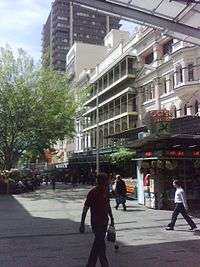Facadism


Facadism, façadism (or façadomy[1]) refers to an architectural and construction practice where the facade of a building was designed or constructed separately from the rest of a building. More often it refers to the practice where only the facade of a building is preserved with new buildings erected behind or around it.
There are aesthetic and historical reasons for preserving building facades. Facadism can be the response to the interiors of a building becoming unusable, such as being damaged by fire. In developing areas, however, the practice is sometimes used by property developers seeking to redevelop a site as a compromise to preservationists who wish to preserve buildings of historical or aesthetic interest. It can be regarded as a compromise between historic preservation and demolition and thus has been lauded as well as decried.
There is sometimes a blurred line between renovation, adaptive reuse, reconstruction and facadism. Sometimes buildings renovated to such an extent that they are "skinned", preserving the exterior shell and additionally used for purposes other than what they were originally intended. While this is equivalent to facadism, the difference is typically retention of roof and or floor structures, maintaining a credible link to the original building. In contrast, facadism typically involves retaining only one or two street facing walls for purely aesthetic and decorative purposes.[2] Facadomy is a practice in postmodern architecture reaching its peak in the latter half of the 20th century. The setback or podium architecture technique gives an illusion of integrity to the original building by visually separating the old from the new, helping to mitigate farcical effects such as the floors and windows not lining up or a dramatic clash of styles.
Critics label the practice as architectural sham, claiming that it sometimes results in part of the building becoming a folly.
Distribution and control measures
Despite being highly controversial and denounced by many preservationists as vandalism, facadism is used as the demand for new development is overwhelming community desires for preservation. Facadism appears often in cities where there is a strong pressure for new development.
While the controversial practice of facadism is encouraged by governments in some cities (such as Toronto, Sydney and Brisbane), it is actively discouraged in others (such as Paris and Melbourne).
Architectural podiums are often seen by some architects as a solution to this problem and these are allowed for as part of planning frameworks in urban heritage areas.
International policies
The practice of facadism conflicts with ICOMOS international charters. The Venice Charter, article 7, states that: A monument is inseparable from the history to which it bears witness and from the setting in which it occurs. The moving of all or part of a monument cannot be allowed except where the safeguarding of that monument demands it or where it is justified by national or international interest of paramount importance.
By country
Australia
In Australia, the Burra Charter has some policies which deal with facadism.
Melbourne
In the rapidly growing city of Melbourne, facadism has existed as early as the 1930s. The Old Commerce building at the University of Melbourne is a prominent example of a building which has been relocated and "stuck on" a newer building.


With the introduction of heritage controls in the later twentieth century, several large buildings have been completely "skinned". These include the T&G buildings on Collins Street and the Savoy Hotel on Spencer Street.
However, implementation applied only to heritage registered buildings and it was relaxed in subsequent years, which allowed several poor examples of facadism to appear particularly with heritage buildings of only local significance. For example, the heritage registered Carlton & United Breweries site is a large site on Swanston Street, Melbourne which has contained hollow suspended facades for almost three decades. That led the Melbourne City Council to rethink the policy.
In the late 1990s, facadism was discouraged with the introduction of a 10-metre policy, which advocated for the retention of at least 10 metres of the front of a building. This helped to retain context and the integrity of important transitions and relationships such as entrances and complex roof structures.
The Olderfleet group of buildings (which includes the Rialto and Winfield) and the 1 Collins Street development are seen as well-executed examples of this preservation policy.
Brisbane
In Brisbane, facadism is encouraged by the Brisbane City Council. An example is the Myer Centre which features extensive facadism of several buildings including the Hotel Carlton (1885), New York Hotel (1860) and Newspaper House. Other buildings which are facaded include the final design includes the facade of the Queensland Country Life Building (1888).
Canada
In Canada, all jurisdictions at the federal, provincial, territorial and municipal level have adopted the Standards & Guidelines for the Conservation of Historic Places in Canada, which does not recommend, though not explicit, facadism as good conservation practice. In general, projects which have approached projects using facadism are considered to have lost their integrity and value.
Gallery
 Reconstruction of an 1890s 7-storey apartment building. Malaya Nikitskaya Street, Moscow.
Reconstruction of an 1890s 7-storey apartment building. Malaya Nikitskaya Street, Moscow. Reconstruction in Bucharest.
Reconstruction in Bucharest. BNPP headquarters on boulevard des Italiens in Paris, rebuilt beside the facade of the famous former restaurant La maison dorée.
BNPP headquarters on boulevard des Italiens in Paris, rebuilt beside the facade of the famous former restaurant La maison dorée.
 Reconstruction of 1918 shopoffices in Kuala Lumpur, Malaysia. A block of shophouses across the road have received similar treatment.
Reconstruction of 1918 shopoffices in Kuala Lumpur, Malaysia. A block of shophouses across the road have received similar treatment. The facade of 48 Leicester Square stands alone in January 2015, after demolition of the building behind it. Originally Fanum House, designed by Andrew Mather and built in three phases 1923-26, 1936-37 and 1956-59
The facade of 48 Leicester Square stands alone in January 2015, after demolition of the building behind it. Originally Fanum House, designed by Andrew Mather and built in three phases 1923-26, 1936-37 and 1956-59 In Manhattan, New York City, New York University agreed to preserve the facade of St. Anne's Church when it built a new dormitory on the site, but did not incorporate the facade into the building, leaving it freestanding in front
In Manhattan, New York City, New York University agreed to preserve the facade of St. Anne's Church when it built a new dormitory on the site, but did not incorporate the facade into the building, leaving it freestanding in front 15 Union Square West was a cast-iron building constructed for Tiffany & Company in 1870. In 2007, a steel-and-glass facade was added in front of the cast-iron facade when it was converted into condominium apartments
15 Union Square West was a cast-iron building constructed for Tiffany & Company in 1870. In 2007, a steel-and-glass facade was added in front of the cast-iron facade when it was converted into condominium apartments The First Church in Boston was rebuilt behind its 19th-century shell after a fire in 1968.
The First Church in Boston was rebuilt behind its 19th-century shell after a fire in 1968.- The 46-story Hearst Tower in Manhattan rises out of the cast stone facade of the original 6-story building
- Air Canada Centre uses the two facades from the original Toronto Postal Delivery Building
 Facade of Toronto Normal School used to form the entrance of the Ryerson Athletics Centre
Facade of Toronto Normal School used to form the entrance of the Ryerson Athletics Centre.jpg) Bank of Canada main building in Ottawa, originally built in 1937.
Bank of Canada main building in Ottawa, originally built in 1937. The atrium above the rapid-transit train platforms for Five Points (MARTA station), Atlanta, Georgia, features the original facade of the Eiseman Building, which was demolished to make way for the station in 1975.
The atrium above the rapid-transit train platforms for Five Points (MARTA station), Atlanta, Georgia, features the original facade of the Eiseman Building, which was demolished to make way for the station in 1975. Soldier Field in Chicago was completely rebuilt in 2002 and 2003, with a new seating bowl being constructed inside the historic original stadium's iconic exterior (most notably retaining the venue's distinctive colonnade).
Soldier Field in Chicago was completely rebuilt in 2002 and 2003, with a new seating bowl being constructed inside the historic original stadium's iconic exterior (most notably retaining the venue's distinctive colonnade). Facade of the former bullfighting ring Plaza de toros de las Arenas, Barcelona, Catalonia. Built in 1900, by 1977 it had fallen into total disuse. It was reopened in 2011 as a shopping centre named Arenas de Barcelona, on a project by Richard Rogers.
Facade of the former bullfighting ring Plaza de toros de las Arenas, Barcelona, Catalonia. Built in 1900, by 1977 it had fallen into total disuse. It was reopened in 2011 as a shopping centre named Arenas de Barcelona, on a project by Richard Rogers.
See also
References
Notes
Bibliography
- Goldberger, Paul (1985-07-15). ""Facadism" On The Rise: Preservation Or Illusion?". The New York Times. Retrieved 2006-09-21.
- Heffern, Sarah (April 26, 2001). "When History Is Only Skin Deep". Preservation Online. National Trust for Historic Preservation. Retrieved July 22, 2013.
- King, John (2005-02-22). "Insulting historic preservation". San Francisco Chronicle. Retrieved 2006-09-21.
- King, John (2006-09-20). "Classics preserved -- or are they?". San Francisco Chronicle. Retrieved 2006-09-21.
External links
 Media related to Facadism at Wikimedia Commons
Media related to Facadism at Wikimedia Commons